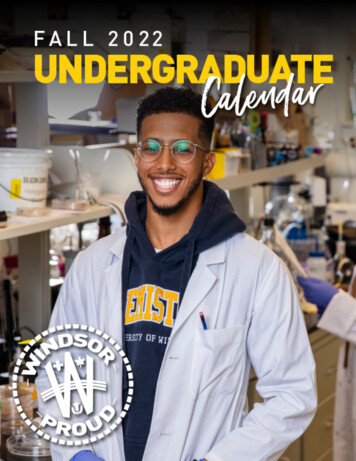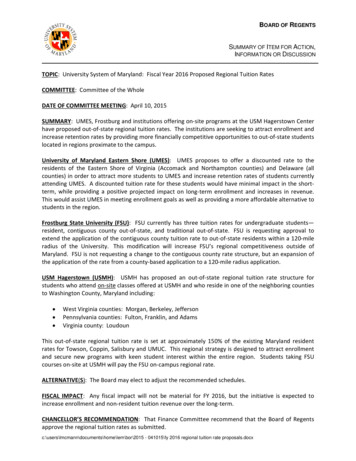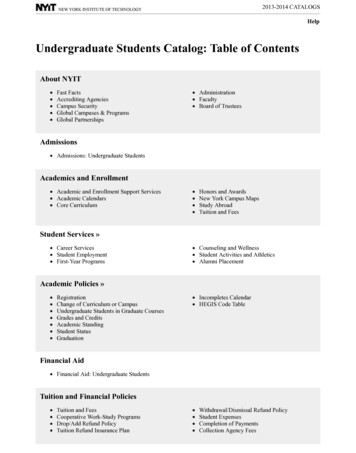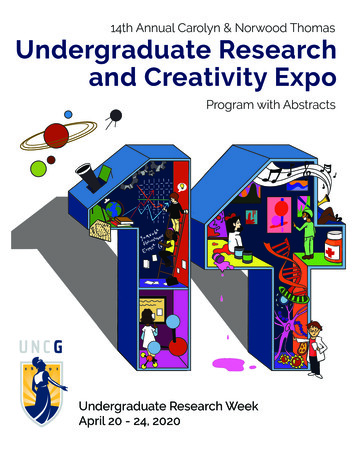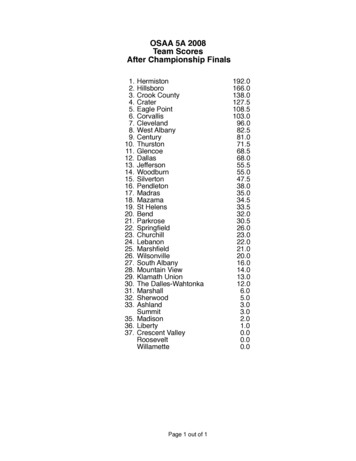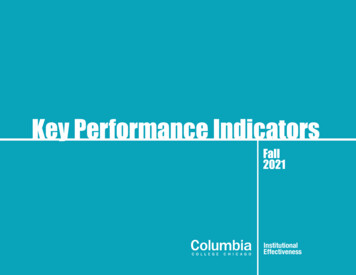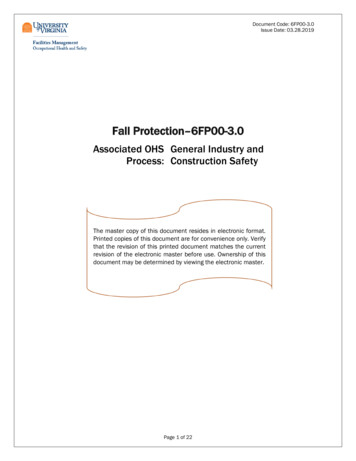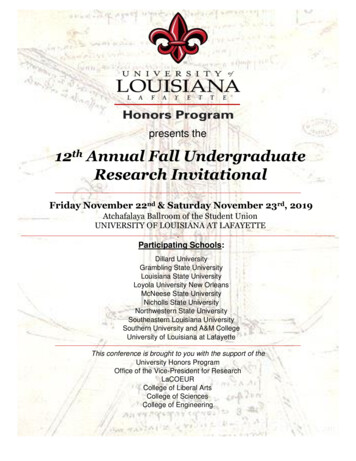
Transcription
presents the12th Annual Fall UndergraduateResearch InvitationalFriday November 22nd & Saturday November 23rd, 2019Atchafalaya Ballroom of the Student UnionUNIVERSITY OF LOUISIANA AT LAFAYETTE.Participating Schools:Dillard UniversityGrambling State UniversityLouisiana State UniversityLoyola University New OrleansMcNeese State UniversityNicholls State UniversityNorthwestern State UniversitySoutheastern Louisiana UniversitySouthern University and A&M CollegeUniversity of Louisiana at LafayetteThis conference is brought to you with the support of theUniversity Honors ProgramOffice of the Vice-President for ResearchLaCOEURCollege of Liberal ArtsCollege of SciencesCollege of Engineering
Table of ContentsTable of Contents2Acknowledgements3A Little About UL Lafayette4Parking Information5Our Distinguished Speaker6UL Lafayette Union Map7Schedule of Events8Posters (Alphabetically by Title)9Schedule for Oral Presentations60Note Paper812
AcknowledgementsI would like to take the opportunity to thank a number of people who made this possible. Noundertaking this large is ever created by one person. The thanks go to Dr. Ramesh Kolluru, VicePresident for Research, Innovation, and Economic Development, Dr. Terrence Chambers and theUndergraduate Research Committee, without whose help this would never had happened.Thanks to the staff at Honors, Mr. Ryan Winters, Mrs. Renauda Helaire, and Professor Mary EllenStegall for their continuous support and service to this project. Thank you also to our esteemedcollege deans for their unwavering enthusiasm and support. Additional thanks to the faculty fortheir tireless efforts in helping and encouraging students to pursue undergraduate research. Wethank all of our volunteers who have dedicated personal time and effort to help this event runsmoothly. We also appreciate the directors and staff at the UL Lafayette Student Union forgraciously making their buildings available to us. Lastly, I wish to acknowledge all the time andenergy that the students who attend this conference expend to create their work and to come toLafayette to share it.3
About the University of Louisiana at LafayetteFounded in 1900, the University of Louisiana at Lafayette (then the SouthwesternLouisiana Industrial Institute, the largest member of the University of Louisiana System, is a publicinstitution of higher education offering Bachelor’s, Master’s, and Doctoral degrees. Within theCarnegie classification, UL Lafayette is designated as a research university with high researchactivity. The University’s academic programs are administered by the Colleges of Arts, Education,Engineering, General Studies, Liberal Arts, Nursing & Allied Health Professions, Sciences, theB.I. Moody III College of Business Administration, and Graduate School.The University is dedicated to achieving excellence in undergraduate and graduateeducation, in research, and in public service. For undergraduate education, this commitmentimplies a fundamental subscription to general education, rooted in the primacy of the traditionalliberal arts and sciences as the core around which all curricula are developed. The graduateprograms seek to develop scholars who will variously advance knowledge, cultivate aestheticsensibility, and improve the material conditions of humankind. The University reaffirms its historiccommitment to diversity and integration.Thus, through instruction, research, and service, the University of Louisiana at Lafayettepromotes regional economic and cultural development, explores solutions to national and worldissues, and advances its reputation among its peers.About the University Honors ProgramThe Honors Program at the University of Louisiana at Lafayette provides serious andhighly motivated undergraduate students with an enhanced set of educational opportunities sothat those students who seek added dimension, enrichment, and challenge in their studies mayfind realization of their potential. In a society where Honors programs are short-lived and superioreducation is no longer highly valued, UL Lafayette stands proud as one of the earliest establishedprograms of its kind in Louisiana.With over 1,500 students, the UL Lafayette Honors Program, one of the largest in thestate, is an active member of the Louisiana, Southern Regional, and National Honors Councils.We are known nationwide as leaders in collegiate Honors education. The program is based onthe philosophy per sapientiam felicitas – “through knowledge, happiness”.4
Parking InformationParking has been reserved for conference participants and attendees inZone 15 (E.K. Long) located at the corner of Girard Park Circle and St.Mary Blvd.5
Guest SpeakerHector M. LaSala“Beauty Will Save the World” DostoevskyIt is our great pleasure to introduce Professor Hector M. LaSala from our Architecture programto speak to the rekindling of beauty in the world around us. Hector LaSala was born in ElSalvador. He received his architecture degree from the University of Louisiana at Lafayette in1973, and conducted his graduate studies at Texas A&M University. Hector has been teachingat UL Lafayetteʼs School of Architecture and Design for over thirty years, and was a visitingprofessor at Virginia Tech in 1983. He is a member of the graduate faculty.The central motivation of his academic career has been teaching, in particular freshmen. Inrecognition of his teaching and research, his peers have honored him with two of ULʼs mostprestigious accolades: the 2001 Excellence in Teaching Award and the 2008 DistinguishedProfessor Award. Concurrently, for several years, Hector and his colleagues Geoff Gjertson andCorey Saft have conducted numerous Service Learning initiatives with over 300 students. Inrecognition of this effort, he received the 2007 Oliver-Sigur Humanitarian Service Award.Additionally, he has been a member of the Kennedy Centerʼs Partners in Education programsince 1995, whose purpose is to integrate the arts throughout the K to 12th grade curriculum.For this endeavor, Hector and his team members were granted the 2004 Governorʼs Arts Awardfor Outstanding Contribution to Arts Education. Hector also currently holds the title of SlemcoProfessorship in the Arts.Publications and Recent Research: "Common Sense: Published Results of RebuildLouisiana," (Gjertson, LaSala, McClure, and Saft) 2006 "Up to Speed," Julia Mandel. Metropolis Magazine. 2006"Fabricating a Pedagogy While Mending Tears." (LaSala, Gjertson) 2006"Improvisation." ACSA Southwest Regional Proceedings. (Saft, LaSala, McClure andGjertson) 2005"Accelerated Fabrication: A Catalytic Agent Within a Community of Caring" (LaSala,Gjertson). M.I.T. Press, Boston Massachusetts, May 2005."FABRICation: Digital Improvisation." Gjertson, LaSala. National Acadia/AIA FabricationConference6
University of Louisiana Lafayette Honors ProgramUndergraduate Research InvitationalFall 2019Dillard UniversityGrambling State UniversityLouisiana State UniversityLoyola University New OrleansMcNeese State UniversityNicholls State UniversityNorthwestern State UniversitySoutheastern Louisiana UniversitySouthern University and A&M CollegeUniversity of Louisiana at LafayetteUL Lafayette Student Union Map**Please note the designated presentation rooms on the following page.7
Friday, November 22ndAll Conference Rooms are in the Student Union5:00 pm – 6:00 pmArrival and Conference Check-inHallway Outside Atchafalaya Ballroom6:00 pm – 7:15 pmBanquet & Keynote SpeakerAtchafalaya Ballroom7:30 pm – 8:30 pmPoster Session 1*Magnolia Room — Biology*Pelican Room — Psychology, Criminal Justice*Shadows Room — Engineering, Physics8:45 pm – 9:45 pmPoster Session 2*Magnolia Room — Chemistry, Sciences*Pelican Room — Computer Science, Health, ArchaeologyEnvironmental Science, Communication*Shadows Room — Kinesiology, Physiology, AnthropologyFamily & Consumer Science, SociologySaturday, November 23rd7:00am – 8:30amBreakfast (Hotel Guests Only @ Hotel Restaurant)8:30am – 9:45amFirst Oral Session 6 total – 2 per room*Breakout Rooms 1-5 See Program10:00am – 11:15amSecond Oral Session 8*Breakout Rooms 1-411:30am – 12:45pmLunchAtchafalaya Ballroom1:00pm – 2:15pmThird Oral Session 6*Breakout Rooms 1-3*See individual presentation listings for room designations.8
Poster PresentationsFriday, November 22nd, 2019 7:30-9:45PMListed Alphabetically by TitleA Comparison of Levels of Burnout in Occupational Therapists in Louisiana*Session 2 – Pelican RoomPresenter: Ly Ly ChiassonArea of Study: Occupational Therapy and Allied HealthAdvisor/Co-Author: Jennifer PlaisanceSchool: Nicholls State UniversityAbstract:Burnout is often described as feelings of exhaustion and dissatisfaction towards one’s workexperience. The abbreviated Maslach Burnout Inventory (aMBI) separates burnout into threecomponents: emotional exhaustion (EE), depersonalization (DP), and personal accomplishment(PA). Each of these three components is individually measured to determine how influentialeach aspect is. Purpose: This study was meant to examine levels of burnout, to identify themost prominent component of burnout, and to determine correlations between burnout andvarious demographic characteristics of Louisiana occupational therapists (OTs). Methods:Thirty-six occupational therapists completed a survey consisting of the aMBI and questionsregarding demographic information. Results: Occupational therapists reported lowDepersonalization scores and high Personal Accomplishment scores, which are indicative oflow burnout levels. However, occupational therapists also reported moderate levels ofEmotional Exhaustion, indicating that this is the most prominent aspect of burnout. Furtheranalysis showed that burnout was associated with younger occupational therapists, as well asthose who are unmarried. Burnout was also associated with those occupational therapists whoworked with adolescents and young adults, as well as the elderly. Conclusions: This study waspursued to provide more information about burnout so that occupational therapists can becomemore aware of symptoms, allowing them to take the necessary steps to cope with thisphenomenon. To further combat burnout, various coping mechanisms can be implemented inoccupational therapy workplaces.A Cross-Cultural Examination of Autism Spectrum Disorder*Session 1 – Pelican RoomPresenter: Maddison BengeArea of Study: PsychologyAdvisor/Co-Author: Dr. Margaret E. CochranSchool: Northwestern State University of LouisianaAbstract:Autism Spectrum Disorder (ASD) is characterized by neurobiological deficits consisting ofdifficulty in social communication and interaction; lack of skills in the ability to develop,understand, and maintain relationships; lack of social reciprocity in communication especiallynonverbally; and significant impairment in an individual’s life due to these characteristics(American Psychiatric Association, 2013). Diagnosis and treatment of ASD differs from country9
to country, however, it may be possible to recognize a more standardized approach inidentifying the indicators of ASD, as well as possible alternative effective treatment options forthose affected by ASD to improve their life outlook. Although extensive research has beenconducted regarding the diagnosis and treatment of this disorder, further research is needed tobetter standardize and define ASD so that diagnostic methods and treatments can be appliedcross-culturally. Cultural traits such as gender roles, politics, sociodemographic background,and other factors appear to affect the age of diagnosis, testing protocol, and treatment optionsfor ASD in the United States, Japan, Nepal, and Brazil.A New Strategy for Designing Planar Tetracoordinate Carbon Systems: Carbon MetalClusters Possessing Magic Number Total Electron*Session 2 – Magnolia RoomPresenter: Isha SharmaArea of Study: ChemistryAdvisor/Co-Author: Kiran BoggavarapuSchool: McNeese State UniversityAbstract:The design of systems with tetracoordinate but not tetra carbon is an established area ofchemical research. To date, strategies can be divided into two methodologies-mechanicalmethods which can sterically confine carbon to a plane, and electronic methods which stabilizethe unique electron arrangement of planar tetracoordinate carbon. This DFT study appliesmagic number electron counting to carbon group 10 metal clusters of the type CMn CM Zn, Cd,Hg; n 4,8. Stoichiometry with 12 total valence electrons are unstable in the tetrahedralconformation and prefer a pseudo planar coordination. Global minima search for clusterspossessing 20 total valences electrons reveal a preference for capped, square-antiprismaticmolecular geometry with a stable pseudo planar carbon geometry. Preliminary results indicate apossible connection between localized carbon geometry, and total valence electron count.A Parallelized In-Memory Database System for the Discovery of Predictive CoOccurrences within Streaming Time Stamped Data*Session 2 – Pelican RoomPresenter: Matthew HigginbothamArea of Study: Computer ScienceAdvisor/Co-Author: Dr. Jennifer Lavergne; Ethan FranksSchool: McNeese State UniversityAbstract:Predictive analytics utilizes information extracted from big data (both real-time and historical) inorder to forecast potential future occurrences with an acceptable level of reliability. As timeprogresses, especially in this information age, trends change at an explosive rate. As a result, itcan be especially hard for companies and individuals to react in time to take advantage and/orproperly react to these changes. Some examples are emerging disease, increased hospitalpatients at certain times of the year, increase/decrease in traffic accidents under certainconditions. The main objective of this project is to develop a parallelized in-memory patternmining framework for dynamic data mining. Utilizing an in-memory database allows for faster10
information processing, dynamic structure growth as time progresses, and advanced cooccurrence discovery. By parallelizing and making modifications to the structure, this projectplans to increase processing speed, allow for the discovery of new, previously undiscovered cooccurrence types, and to decrease the wait time between discovery of a new occurrence andimplementation.A Qualitative Analysis of Parental Vaccination Decision Factors*Session 2 – Magnolia RoomPresenter: Bailie MarshArea of Study: Scientific InquiryAdvisor/Co-Author: Dr. William HouselSchool: Northwestern State UniversityAbstract:Fear and misinformation have fueled the anti-vaccination movement and have inspired manyparents in Western countries to forgo vaccinating their children. People have opposedvaccinations since the first was developed, and despite the reduction and elimination of manyinfectious diseases, some parents are under the impression that vaccines are more harmfulthan beneficial. Safety is not the only concerning factor that causes hesitation among parents.Parents also choose not to vaccinate their children for religious reasons, socioeconomicstruggles, and because of vaccination propaganda presented on social media platforms. Agreater number of parents today are not utilizing common vaccinations, such as the MMRvaccine, the HPV vaccine, and the influenza vaccine, for their children. Examinations of beliefand opinion are necessary to address the concerns of parents and to alternatively provideaccurate information regarding the benefits of vaccines. A survey was developed to examinecommon factors that contributed to the decision-making process for parents who consideredvaccinating their children.A review on current status of Biodegradable Plastics*Session 1 – Shadows RoomPresenter: Tam T T TranArea of Study: Chemical EngineeringAdvisor/Co-Author: Dr Srinivasan AmbatipatiSchool: McNeese State UniversityAbstract:The global plastic production has rapidly increased from around 1.5 million metric tons in 1950to around 348 million metric tons in 2017. This makes plastic not only the most versatile andubiquitous material, it also created a crisis in the form of plastic waste in the world. A hugeamount of daily-use synthetic plastic products is non-biodegradable such as polyethylene (PE),polyethylene terephthalate (PET), polyvinyl chloride (PVC), polypropylene (PP), polystyrene(PS), etc. Only a little fraction of plastic products is recycled and the majority of it ending up inlandfills and eventually leaking into marine environments. Moreover, the decomposition of nonbiodegradable plastic products under the natural environmental conditions takes from a fewyears to few hundred years. Biodegradable plastic products are plastic that made from biomassor petrochemical source such as starch, plant protein, oil, lignin, cellulosic materials, crude oil,11
natural gas, and coal that can decompose naturally in the landfills and/or marine environmentunder the action of microorganisms like bacteria, fungi or the action of biological enzymes. Theprocess of decomposition of the biodegradable plastic will release water and carbon dioxide inaerobic environment. Biodegradation takes a few weeks to a few years. That means thebreaking down of chemical structure of biodegradable plastics is faster than non-biodegradableplastics. This research review will highlight the current status of available biodegradable plasticsand their mechanism of biodegradation and the factors affecting the biodegradation rate. Thisresearch will also make conclusions on potentially viable processes to reduce the impact ofplastic waste on the environment.Aerobic Overtraining Protocol Mitigates Glucose Intolerance and Does Not ImpairRunning Performance in C57bl Mice*Session 2 – Shadows RoomPresenter: Hannah HardinArea of Study: KinesiologyAdvisor/Co-Author: David Bellar, Scott Fuller, Greggory R. Davis, Derek ScottSchool: University of Louisiana at LafayetteAbstract:It is unclear what role glucose uptake may play in contributing to glycogen depletion inovertraining. Therefore, the purpose of the study was to determine if a treadmill overtrainingprotocol would affect glucose tolerance, as a measure of glucose uptake.Methods: 18 male mice were divided into a control group (CON), exercise group (EXE), and anovertraining group (OTS). A glucose tolerance test (GTT) was performed at 0, 20, 40, 60, and120 min pre- and post-intervention. An incremental load test (ILT) was performed pre- and postintervention. EXE and OTS completed a 4-week conditioning protocol 5 days/week. For the next4 weeks, EXE continued the conditioning protocol while OTS performed the overtrainingprotocol.Results: There was a significant group (F 31.62; p 0.01), time (F 91.24; p 0.01), andinteraction effect (F 9.03; p 0.01) for performance, as measured by EV. However, EV did notdiffer between the EXE (24.4 1.7 m/min) and OTS (25.0 0.2 m/min) groups post-intervention(p 0.91). There was significant group (F 14.46; p 0.01) and interaction effects (F 17.37; p 0.01), but not time (F 0.84; p 0.37) for GTT area under the curve (AUC). The AUC postintervention for CON, EXE, and OTS were 42413.3 1799.9 AU, 31948.3 2019.6 AU, and25563.3 816.7 AU, respectively. Body weight significantly increased in all groups (CON 5.77 0.98 g; EXE 4.48 0.62 g; OTS 1.88 0.36 g), though the increase was significantlygreater in the CON (p 0.01) and EXE (p 0.04) groups compared to the OTS group.Conclusions: GTT and EV were significantly improved in EXE and OTS groups compared toCON. The overtraining protocol did not worsen exercise performance or GTT.12
America's Next Top Species: An Analysis of Species Recovery*Session 2 – Magnolia RoomPresenter: Aron StephensArea of Study: Scientific InquiryAdvisor/Co-Author: Dr. Margaret E. CochranSchool: Northwestern State UniversityAbstract:Human activities such as poaching, deforestation, and habitat destruction can reduce populationnumbers to the point that a species is unable to recover and is ultimately driven extinct.Typically, such species are in danger of extinction due to one or more factors associated withrarity, such as geographic range, habitat specificity, and local populations size. A species ineminent danger of extinction throughout all or a significant portion of its range may qualify forthe legal designation of endangered; specific needs such as habitat, range, and presence ofother species are considered when classifying a species as endangered or threatened. TheEndangered Species Act serves to protect these organisms from human activities that mayhave a negative impact on their long-term viability. The effectiveness of this legislation may bedependent upon the life history of the target organism, the environment in which it lives, thetypes of human activity that affect it, and the type of organism itself. A rubric is proposed toevaluate the recovery status of endangered species and allow comparisons across classes ofanimals.Analysis of Cd, Cr, Cu, Pb, and V in Soils of Northwestern State University Showed NoElevated Levels That Pose Serious Health R*Session 2 – Magnolia RoomPresenter: Abigail Poe & Lawson ScottArea of Study: ChemistryAdvisor/Co-Author: Dr. Chad Thibodeaux, Mr. Millard Mangrum, Colby KoontzSchool: Northwestern State UniversityAbstract:This study compared the concentration of select heavy metals (Cd, Cr, Cu, Pb, and V) in soilscollected from locations around the campus of Northwestern State University of Louisiana. Twosites chosen were where buildings, Guardia Hall and Caldwell Hall, had been destroyed by fire,with three additional sites sampled. In particular, this project sought to determine whether theconcentration of these heavy metals was increased in locations where documented structuralfires had occurred compared to other areas on campus. Samples were collected, prepared foranalysis by acid digestion according to EPA Method 3050B, and analyzed using ICP-OES.13
Applying Cultivation Theory to New Media*Session 2 – Pelican RoomPresenter: Elizabeth ButlerArea of Study: Mass CommunicationAdvisor/Co-Author: Dr. Claire JoaSchool: Louisiana State University at ShreveportAbstract:The cultivation theory has been used to describe the effects of excessive television mediaconsumption on viewers' perceptions of reality. Conceived in the late 1960s, the theorypostulates that prolonged exposure to messages disseminated via mass media such astelevision is enough to influence or alter people’s perceptions of the reality around them, beliefs,and moral values. Consequently, those who are exposed to media fail to distinguish betweenwhat is scripted behind cameras and the factual social reality around them. Numerouscultivation theory researchers have explored the media effects that media messages usuallyinfluence people’s perceptions of reality by mirroring mainstream values of society. In thecurrent media environment where television media still play a critical role in shaping key mediaagenda but the way it influences have changed. People watch television media through socialmedia and create online memes using their content, thus we need to revisit the cultivationtheory and discuss how the media effects have evolved into something else. The purpose of thispaper is thus to explore in detail the cultivation theory and determine how it explains the effectof too much consumption of television on society; how this cultivates perceptions and influencesmindsets. The paper will employ an exploratory research method to find and analyzeinformation from Co-sources that insightfully expound on the cultivation theory assumptions inthe current media environment. The research questions were proposed to examine and revisitthe assumptions of the cultivation theory and the positive and negative impacts of televisionviewing today along with long- and short-term outcomes.Assembly of a Palladium(Ii) Cornered Square Macrocycle from a Cyclic Cisoid DiamideLigand*Session 2 – Magnolia RoomPresenter: Andrew D. BrattonArea of Study: ChemistryAdvisor/Co-Author: Semin Lee, Xin XhouSchool: Louisiana State UniversityAbstract:Hydrogen-bonded organic frameworks (HOF) are a class of self-assembled, porous materialsheld together by hydrogen bonds and other noncovalent interactions. These solid materialshave found potential applications in gas-storage, gas-separation, drug-delivery, and catalysis.Here, we introduce cyclic cisoid diamide (CCD) as a hydrogen-bonding motif that also providesa 90 bend angle that allowed the design of a square-shaped macrocycles. Two pyridyl-ligandmoieties were appended on either end using Suzuki cross-coupling. Upon coordination withpalladium(II) corners, that also have 90 coordination angles, a CCD2Pd2 macrocycle wasformed. Synthetic methods of the compounds and their various characterization techniquesincluding nuclear magnetic resonance (NMR) spectroscopy, mass spectroscopy, and single14
crystal X-ray crystallography will be presented. Chirality and hydrogen bonding assemblies wereclosely investigated using these data. The future goal of this research is to create a HOF formedfrom CCD moieties that may go on to have industrial application or to contribute to futureresearch in this area.Assessing Color Variation in Neotropical Electric Fish STEATOGENYS ELEGANS*Session 1 – Magnolia RoomPresenter: Alyson NguyenArea of Study: BiologyAdvisor/Co-Author: Dr. James Albert, Aeran MelanconSchool: University of Louisiana at LafayetteAbstract:Steatogenys elegans is a species of freshwater electrical fish, one of three species in the genusSteatogenys S. elegans, commonly known as the barred knifefish, is characterized by thick,dark vertical bands along its entire body. A laboratory at the University of Louisiana at Lafayette,currently under Dr. James Albert, has a preserved population of what was originally thought toall be of S. elegans, but there has been recent speculation on whether there could beindividuals from more than this one species. So, a sample population of 50 fish were chosen atrandom from the preserved population. Each fish was photographed and then analyzed, usingImageJ to measure gray scale values of the pixels of the dark and light bands. Current resultscould not provide significant evidence to the existence of more than one distinct color variation.Future studies with the same population can be done utilizing a larger sample of the preservedpopulation or measuring color values among other ways.Atom Transfer Radical Polymerization by Continuous Feeding of Activators*Session 2 – Magnolia RoomPresenter: Alec ClayArea of Study: ChemistryAdvisor/Co-Author: Dr. Yu WangSchool: University of Louisiana at LafayetteAbstract:Atom transfer radical polymerizations (ATRP) of methyl acrylate (MA), methyl methacrylate(MMA) and styrene (St) were conducted by continuous feeding of Cu(I)X/Ligand activators.Typically, the monomer, the initiator, and a certain amount of deactivator, Cu(II)X2/Ligand, wereplaced in a Schlenk flask deoxygenized by bubbling with N2. The activator, Cu(I)X/Ligand, wasplaced in a gas-tight syringe and was added at a constant rate to the Schlenk flask using asyringe pump. In ATRP, the Cu(I) catalyst would undergo many oxidation/reduction cycles whenthe propagation of polymer chains is taking place. However, some of the Cu(I) would finally beoxidized to Cu(II) irreversibly. According to the principle of halogen conservation, the end-grouploss equals the amount of Cu(I) that is permanently oxidized to Cu(II). Thus, by reducing theamount of Cu(I) added to the reaction, ATRP by continuous feeding of activators sets an upperlimit of the potential end-group loss. The end-group fidelity information is readily known at thebeginning of the reaction.15
Biosurveillance of Ticks and Associated Pathogens in Belize*Session 1 – Magnolia RoomPresenter: Razan Amira BadrArea of Study: BiologyAdvisor/Co-Author: Dr. Yvonne-Marie Linton, John Tarpey, Reed Mitchell, David PecorSchool: Loyola University New OrleansAbstract:Belize is a tropical country hosting a rich biodiversity and diverse landscapes, ranging fromlowlands and swamps in the north to rainforests and mountainous regions in the south. It is alsotraining grounds for U.S. soldiers. Ticks can carry and transmit dangerous pathogens that putboth local residents and soldiers at-risk. Herein we compare 564 ticks collected in two villages(Red Bank & San Roman) in the SE district of Stann Creek in 2018 with those collected in 2014& 2015 from Cayo (SW), Orange Walk (NW), and Corozal (N) Districts (n 154) (Polsomboomet al. 2017).Stann Creek ticks were primarily collected off local dogs, with a few samples collected fromhorses and by dragging. DNA was extracted from 564 ticks and DNA barcodes successfullyobtained from 417 confirming the presence of 10 taxa: Amblyomma auricularium, A. coelebs, A.imitator, A. maculatum, A. nr oblongoguttatum, A. ovale, A. sp. nr ovale, A. tapirellum,Dermacentor nitens, Rhipicephalus sanguineus. All 10 taxa were collected on dogs, A.tapirellum and D. nitens on horses, and A. ovale and D. nitens found by environmentaldragging. Differences were detected in tick species recovered across the four districts sampledto date (Corozal (N), Orange Walk (NW), Cayo (SW) and Stann Creek (SE)). All 564 ticks werealso screened for Rickettsia spp., Babesia spp., Borrelia microti, Borrelia spp., and Ehrlichiaspp. using a series of available species- and genus-diagnostic primers. All positive ampliconswere sequenced and resultant sequences blasted in GenBank. Seven ticks were found to beinfected: six by Rickettsia parkeri (A. ovale (n 5), 1 unidentified) and one by Ehrlichia canis(specimen unidentified). All infected ticks were restricted to San Roman village. It is important tounderstand the connections between vectors and the pathogens they may carry to work towardspreventative measures and improving healthcare.Cell-Penetrating MK2 Inhibitory Peptide Blocks LPS-Induced Expression of Proinflammatory Cytokines in HepG2 Hepatocytes*Session 1 – Magnolia RoomPresenter: Tiff
Engineering, General Studies, Liberal Arts, Nursing & Allied Health Professions, Sciences, the B.I. Moody III College of Business Administration, and Graduate School. The University is dedicated to achieving excellence in undergraduate and graduate education, in research, and in public service. For undergraduate education, this commitment

